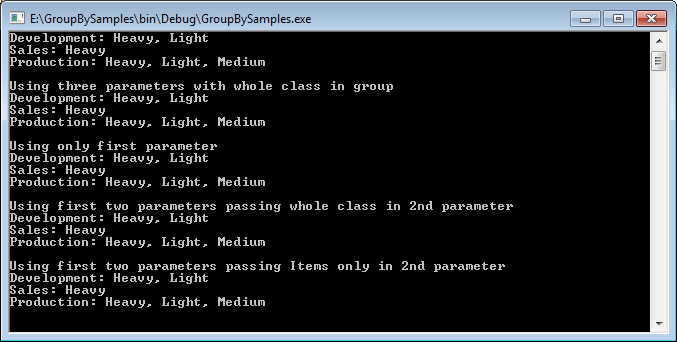Introduction
I recently tried to lookup information on the Linq GroupBy, and found that it was very poorly explained. I hope that this tip helps people trying to use GroupBy.
Here is how GroupBy is defined in MSDN:
public static IEnumerable<IGrouping<TKey, TElement>> <code>GroupBy</code><TSource, TKey, TElement>(
this IEnumerable<TSource> source,
Func<TSource, TKey> keySelector,
Func<TSource, TElement> elementSelector
)
Not very helpful, is it?
The Classes Used for Sample
For this tip, two class types are used. The main class, Department, has an IEnumerable property Items, which is of type Item. I did this because this is a complex case, and I think it provides better visibility on how to deal with more complex cases than a simple single level hierarchy:
public class Department
{
public string Name { get; set; }
public string DepartmentType { get; set; }
public List<Item> Items { get; set; }
}
public class Item
{
public string Name { get; set; }
public string ItemType { get; set; }
}
Different Ways to Skin the Rabbit
The following all provide the same result, but do them in different ways using the GroupBy to obtain the same result:
var results = departments
.GroupBy(o => o.DepartmentType)
.Select(x => new
{
Type = x.Key,
ItemTypes = x.SelectMany(items => items.Items)
.Select(item => item.ItemType).Distinct().OrderBy(k => k).ToList()
});
var results = departments
.GroupBy(o => o.DepartmentType, o => o)
.Select(x => new
{
Type = x.Key,
ItemTypes = x.SelectMany(items => items.Items)
.Select(item => item.ItemType).Distinct().OrderBy(k => k).ToList()
});
var results = departments
.GroupBy(o => o.DepartmentType, o => o.Items)
.Select(x => new
{
Type = x.Key,
ItemTypes = x.SelectMany(items => items)
.Select(item => item.ItemType).Distinct().OrderBy(k => k).ToList()
});
var results = departments.GroupBy(o => o.DepartmentType, o => o, (key, g) => new
{
Type = key,
ItemTypes = g.SelectMany(items => items.Items)
.Select(item => item.ItemType).Distinct().OrderBy(k => k).ToList()
});
var result1 = departments.GroupBy(o => o.DepartmentType, o => o.Items, (key, g) => new
{
Type = key,
ItemTypes = g.SelectMany(item => item)
.Select(item => item.ItemType).Distinct().OrderBy(k => k).ToList()
});
Hopefully, the code is self-explanatory.

Notes:
If you have any suggestions on how this could be improved, please contact me. There are a several people that have not given this 5 stars and would like to know how I could make it more useful.
Conclusion
Hopefully, these samples will quickly help you in understanding the GroupBy. I looked at a bunch of tips, samples, and articles that tried to explain the GroupBy. Hopefully, this will be more useful.
History
- 2018-05-17: Initial version
